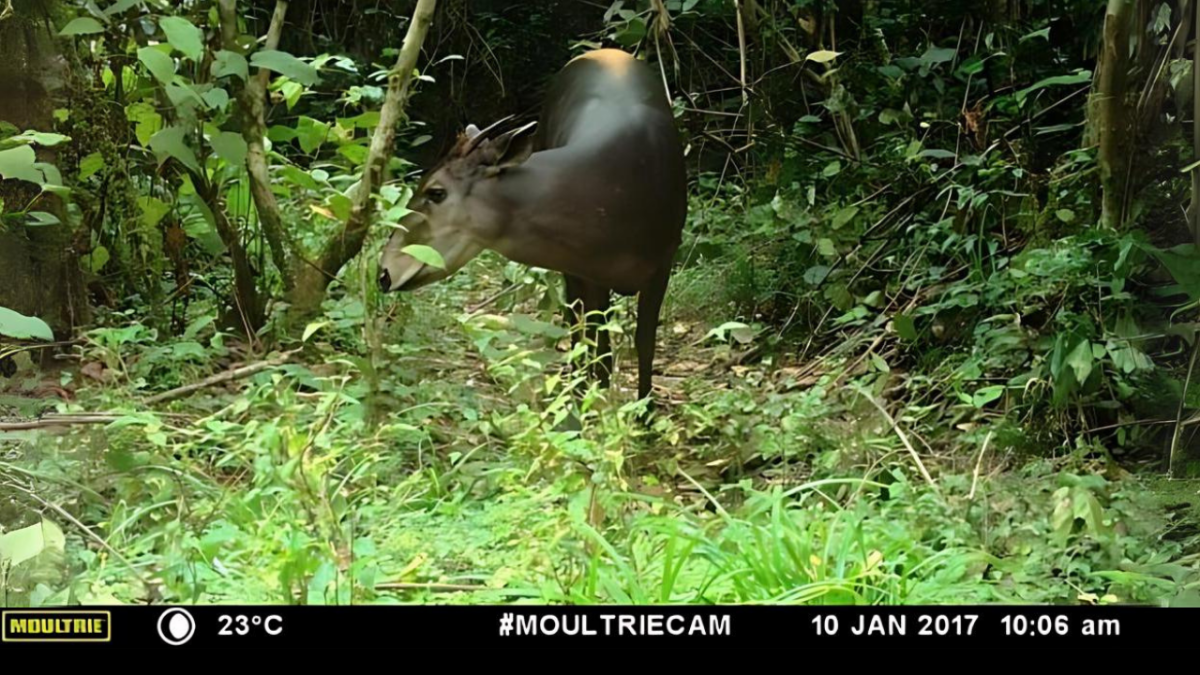
New research unveils the hidden complexity of antelope seed dispersal in Congo Basin tropical forests
Seed size, forest type and duiker species all factor into how seeds are dispersed
The health and structure of tropical forests largely depend on seed dispersers — animals that move seeds to new locations where they can grow outside their parent’s shadow.
In the tropical forests of Africa’s Congo Basin, UCLA research in Ecology revealed the multiple pathways seeds are dispersed by three species of forest antelopes, a group called duikers that are indigenous to sub-Saharan Africa.
Duikers disperse seeds in two separate ways, which leads to seeds being deposited in different locations, the researchers discovered. Some seeds are consumed and defecated, while others are swallowed whole and regurgitated during rumination (cud chewing).
Seed size was a major factor in shaping how seeds were dispersed, the paper found. Smaller seeds are defecated, while larger seeds over 10 millimeters in size were regurgitated.
Depending on how seeds were dispersed, defecation versus regurgitation, they were deposited in different proportions across different forest habitats. Nocturnal bay duikers, for example, hide in denser vegetation during the day, bringing large, regurgitated seeds to areas of the forest full of vines, lianas and palms. Some duikers even use fallen trees to nest and disperse seeds right in the canopy gap where new trees are needed, speeding forest regeneration.
Elsa Ordway, paper co-author and UCLA ecologist, highlighted the importance of seed dispersers to African tropical forests.
“Animals disperse the seeds of the overwhelming majority of tree species in the African tropics,” said Ordway, who is co-director of the Congo Basin Institute. “Understanding interactions between important seed dispersing animals and tropical forest structure and function is critically needed to inform effective forest conservation and restoration.”
Each duiker species disperses seeds a bit differently, underscoring the importance of protecting all species for the overall health of the ecosystem, said lead author Bastien Dehaudt, a UCLA graduate and research ecologist at University of Queensland.
“I was surprised how many and how often seeds were dispersed by duikers. There were piles of seeds in all the places we searched,” Dehaudt said. “These animals are true gardeners of the forest, moving an astonishing number of seeds around.”
Field research for the study was conducted in the Dja Biosphere Reserve in southeast Cameroon. Indigenous Baka affiliated with UCLA Congo Basin Institute helped locate and identify seeds dispersed by duikers. To categorize different forest habitats, this study relied on traditional terminology used by the Baka and drone remote sensing technologies.
Baka forest types used in the study
- Mandja: forest with closed canopy and relatively open understory due to the limited light passing through the canopy, making it easier to walk through
- Woundo: forest with semi-closed canopy and semi-closed understory
- Étobé: dense understory often composed of lianas and/or palms, making it difficult to walk through
- Njambo and Ndoumbo: types of swampy areas (combined into one category for research purposes)
When used in conjunction with technologies, traditional knowledge can be a powerful complementary resource for ecological research.
“It was a privilege to work with the Baka and to witness all their knowledge for the forest, Dehaudt said. “This study would not have been possible without them.”
Although ruminants such as antelopes, deer and goats, are abundant around the world, few studies have looked at how they disperse seeds via regurgitation. This research showed how important such animals are to forests. Because duikers regurgitate large seeds, they help perpetuate the dispersal of large-seeded plant species — which often store more carbon — even in forests that have lost their largest animals such as elephants and primates.
Understanding seed dispersal mechanisms is vital to conservation efforts, particularly in regions where hunting and deforestation threaten animal populations. Duikers are often targeted by hunters and many populations have already declined. This study suggests that the loss of duikers could seriously upend forest dynamics, leading to reduced plant diversity and slower forest generation.




